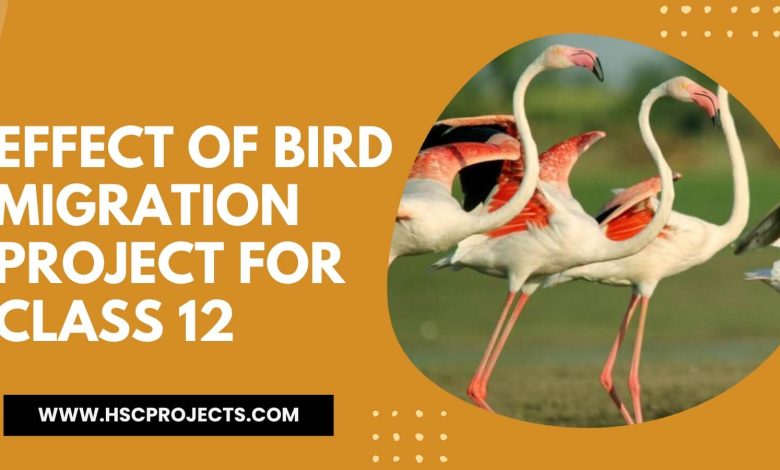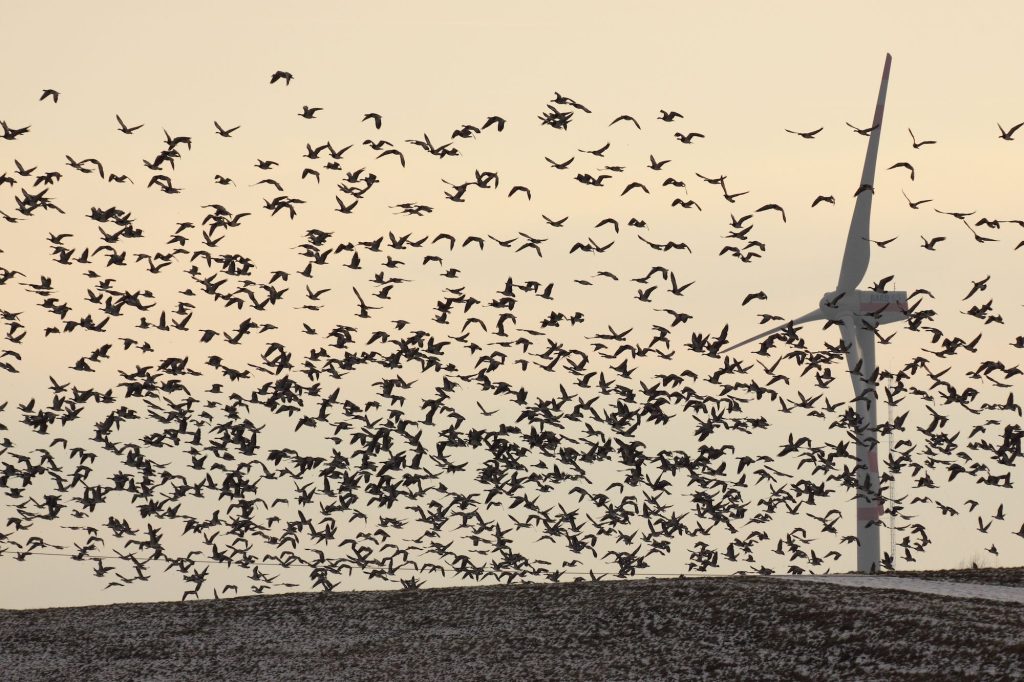
Effect of bird migration project for class 12
Acknowledgment:
I would like to express my heartfelt gratitude to everyone who helped my project on the “Effect of Bird Migration” be completed successfully. I am very appreciative of their invaluable assistance, encouragement, and guidance during this endeavour.
First and foremost, I would want to express my sincere gratitude to my [Teacher/Professor’s Name], whose expertise and insightful feedback were important in helping to shape this project. Their encouragement and commitment to my academic development have been really motivating.
I also appreciate my parents and family’s unwavering understanding and support. They have been a consistent source of inspiration and belief in my abilities throughout this journey.
I would want to express my gratitude to my friends and peers for their insightful comments and stimulating debates that have improved my understanding of the subject. They worked together to make this learning experience enjoyable and rewarding.
In performing the research for this project, I would want to acknowledge the several writers, researchers, and institutions whose works and publications I referred to. Their contributions have helped me broaden my knowledge and mould my perspectives.
I am grateful for the chance to learn more about the wonderful world of bird migration via this project, which has been both gratifying and enlightening. I hope that our project contributes to a better understanding of the significance of bird migration and the significance of conservation efforts with the help of all those mentioned above.
We appreciate your participation in this journey.
Sincerely,
(“Your Name”)
Introduction
Scientists and naturalists alike have been fascinated by the intriguing phenomenon of bird migration for centuries. It refers to birds’ regular seasonal movement, which often covers thousands of kilometres, between their breeding sites and wintering areas. The combination of environmental cues and innate instincts that have evolved over millions of years has enabled birds to adapt to and survive in ever-changing environments, which accounts for their extraordinary behaviour.
Humans have always been enthralled by the graceful flight and tenacity of migrating birds. The accuracy with which these bird travellers navigated over huge landscapes, often returning to the same breeding and wintering locations year after year, astounded early observers. We have gained deeper insights into the complexities of bird migration today thanks to advancements in technology and research, unravelling the mysteries behind their impressive feats.
This project delves into the fascinating world of bird migration, exploring the motivations behind these epic journeys, the many migratory patterns they adhere to, the difficulties they face, and the crucial ecological roles they perform. The economic significance of bird migration will also be examined, along with the cultural and scientific contributions that migratory birds provide to many regions across the world.
Understanding how bird migration affects the environment gives us important new insights into the delicate balance of nature and the significance of conservation efforts to save these remarkable creatures. We will learn how local scientific initiatives and international agreements are collaborating to protect migrating birds and their habitats during this project.
Join us on this fascinating expedition as we explore the wonders of bird migration and come to appreciate these resilient avian travellers much more. We want to foster a deeper understanding of the interconnectedness of all living things via our exploration, as well as the need of preserving their ecosystems.
Bird Migration Definition:
The term “bird migration” refers to a bird’s seasonal movement from one geographic place to another, usually between its breeding grounds in the summer and its wintering sites in the colder months. Regular, long-distance journeys, often covering thousands of kilometres, are undertaken by many bird species, and these journeys are what distinguish this phenomenon. Birds use migration as an adaptive behaviour to maximise their chances of survival by benefiting from seasonal changes in food supply, weather, and breeding opportunities.
Bird Migration Types:
- Nomadic Migration: In search of food and suitable habitats, birds move irregularly and unpredictablely during nomadic migration. These birds do not have a set migration route or schedule; instead, their travel distances depend on the availability of food and their environment.
- Cyclic Migration: Cyclic migration is a pattern that is seen in certain spheres and involves the movement between various regions on a regular schedule in response to the availability of resources. Birds that live in areas with different wet and dry seasons may be seen during this kind of migration.
- Irruptive Migration: Irruptive migration happens when many birds migrate to areas outside of their normal range as a result of changes in the availability of food. This kind of migration is often sparked by changes in food sources, such as an abundance of plants or animals.The migration of leapfrogs is a phenomenon in which people from higher latitudes migrate further than those from lower latitudes. As a result, the breeding and wintering areas of several populations may overlap in a “leapfrog” pattern.
- Moult Migration: Some waterfowl species are observed during their yearly moulting process, during which they shed and replace their feathers, by migrating to certain regions.As a remarkable adaptation, each kind of migration enables birds to maximise their chances of survival and reproduction in response to changing environmental circumstances. These migration patterns may be studied to provide important insights into the complicated behaviours of migrating birds and their interactions with the environment.
- Migration-Related Adaptations:Birds have developed a variety of remarkable adaptations that allow them to successfully complete the difficult process of migration. These modifications are crucial to their survival throughout the exhausting journeys across great distances. Some of the crucial migratory adjustments include:
- Energy Storage and Fat Deposition: Before migrating, birds engage in a period of increased food intake known as hyperphagia in order to accumulate fat reserves. These fat deposits provide as a crucial source of energy for the birds’ flights since they may not have access to enough food while travelling.
- Improved Cardiovascular System: Birds have very effective cardiovascular systems that allow them to maintain prolonged flying times. Their hearts have been modified to pump oxygen-rich blood at a high rate, giving the flying muscles the energy they need.
- Lightweight Skeleton and Muscles: Birds have evolved light-weight bones and striated muscles to reduce the weight they must carry during flight. These modifications minimise energy expenditure and enable swift and effective flying.
- Wings and flying Adaptations: Bird wings are specifically shaped and built for various types of flying. Migratory birds often have long, pointed wings that improve their ability to fly and enable them to cover great distances with little effort.
- Improved Respiratory System: Birds have very effective respiratory systems that enable a constant flow of oxygen during flying. Their lungs’ uniform airflow and air sacs provide a steady supply of oxygen, enhancing their endurance.Birds have highly developed navigational abilities that rely on a mix of innate abilities and environmental cues. They can orient themselves while migrating by using the positions of the sun and stars, the Earth’s magnetic field, landmarks, and even smells.
- Timing Compensation and Circadian Rhythms: As they migrate across various latitudes, birds may modify their internal biological clocks to take into account changes in day length. They may time their flights and arrivals to certain breeding or breeding areas because to this skill.Hormonal changes brought on by day length changes and other environmental cues cause birds to begin their migration at the right time depending on the season. These hormonal changes affect their behaviour, which includes the desire to migrate.
Economic Importance
Beyond the awe-inspiring aspect of birds travelling great distances, migration of birds has economic significance. Birds that migrate have a significant role in many economic sectors and contribute to communities’ livelihoods all around the globe. Some of the important economic aspects of bird migration are as follows:
- Ecotourism and Birdwatching: Both of these pursuits are well-liked by tourists and outdoor enthusiasts. Many areas, especially those along significant bird migration routes, draw birdwatchers who come to see the many and impressive bird species as they migrate. This flood of visitors helps the local economy by spending money on lodging, dining, transportation, and tour services.
- Hunting and Sport Fishing: Migratory birds are hunted in certain areas for both recreational and subsistence purposes. Regulations and licencing relating to the hunting of migrating birds may generate revenue for governments and local communities while also allowing for recreational activities.
- Agriculture and Pest Control: By feeding on insects that might harm crops, several migratory bird species perform a crucial role in agriculture. For instance, swallows and swifts are renowned for their insect-eating tendencies, which might potentially reduce the need for chemical pesticides by reducing pest populations.
- Fisheries and Aquaculture: During migration, many migratory birds, including shorebirds and waterfowl, rely on coastal and wetland environments. These ecosystems are often crucial for commercial and subsistence fishing and aquaculture activities, offering local communities food resources and economic benefits.
- Grants and Conservation funds: Both governmental and non-governmental organisations may provide grants and conservation funds in response to the prevalence of migratory bird species. Many times, projects that are concerned with protecting migrating birds and their habitats get funding for their research, conservation efforts, and habitat restoration.
Migrational birds are included in art, folklore, and traditional practises, and they carry considerable cultural value for many communities. The economic effects of preserving these cultural connections to birds may include travel focused on artistic and cultural experiences.
Scientific Research and Innovation: Monitoring migratory patterns and studying bird migration patterns may provide light on the state of ecosystems and the effects of climate change. This research may result in advancements in environmental management and conservation that will benefit society as a whole.
Case study
Overall, the economic importance of bird migration spans a variety of industries, from agribusiness and ecotourism to fishing and scientific research. Recognising the economic importance of migrating birds brings attention to the significance of conservation efforts to save these incredible creatures and the environments on which they depend. By preserving migratory birds, we not only preserve their inherent ecological value but also advance sustainable economic growth and the preservation of biodiversity.
Case Study 1: Sterna paradisaea, the Arctic Tern
The remarkable Arctic Tern is a migratory bird renowned for its extraordinary journey between its Arctic breeding grounds and its Antarctic wintering areas. This species travels an average distance of over 44, 000 miles (70, 800 km) round-trip each year, making it the bird species with the longest migration routes. The Arctic Tern experiences two summers while migrating around the world, taking advantage of prevailing winds and escaping the bitter Arctic winter.
Significance:
- Ecotourism: The epic journey of the Arctic Tern has made it a popular subject for birdwatchers and nature enthusiasts. Tourists who wish to see this incredible bird journey go to places along its migration route, such as Iceland and Germany.
- Research and Consultation: Understanding the migration of the Arctic Tern may teach us a lot about the ecological needs and navigational skills of migrating birds. Other species in these ecologies benefit from conservation efforts aimed at protecting the breeding and wintering sites of the species.
Case Study 2: Danaus plexippus, the monarch buttefly
The multi-generational journey of the monarch butterfly between North America and Mexico is what makes it so well-known. Millions of monarch butterflies from the United States and Canada go on a journey that covers thousands of miles each autumn to overwinter in the oyamel fir forested regions of central Mexico. In the spring, the monarchs migrate back north, breeding along the way and completing the cycle over many generations.
Significance:
- Ecotourism: The Monarch Butterflies’ overwintering locations in Mexico, including the Monarch Butterfly Biospheric Reserve, attract visitors and researchers, strengthening the local economies and assisting conservation initiatives.
- Agriculture and pollination: Monarch butterflies are crucial pollinators for a variety of plant species. Their presence aids in pollination, ensures the production of crops, and preserves biodiversity, all of which are beneficial to agriculture.
- The Bar-tailed Godwit (Limosa lapponica), Case Study No. 3.
The Bar-tailed Godwit is renowned for having one of the longest non-stop journeys of any bird, covering around 6,800 miles (11,000 km) from Alaska to New Zealand or Australia in only eight days. For the bird to survive, this extraordinary migration is essential because it enables them to access plentiful feeding grounds in the southern hemisphere during the off-breeding season.
Significance:
- Consciousness and Awareness: The migration of the Bar-Tailed Godwit emphasises the need of protecting key stopover sites along its route as well as the coastal and wetland ecosystems that sustain these birds while they are migrating.
- Science: Researching the Bar-Tailed Godwit’s flying and navigation skills advances our knowledge of bird physiology and migratory strategies, spurring advancements in technology and aviation.
These case studies show the variety of migratory patterns and the importance of migrating birds to numerous facets of the environment and human society. They recognise the need of conservation efforts to save these incredible travellers and the environments they depend on for their remarkable journeys.
Conclusion:
The study of bird migration reveals a world of wonder, flexibility, and interconnectedness, in conclusion. The incredible journeys that migrating birds undertake capture our attention and provide insightful information about the delicate balance of nature. We have explored the numerous aspects of bird migration and its significance in various fields throughout this project.
Bird migration is a testament to the amazing adaptations that birds have developed over millions of years that allow them to undertake these difficult journeys. These characteristics enable migratory birds to travel over great distances and overcome environmental challenges, from energy storage via fat deposition to sophisticated navigational abilities.
Additionally to their inherent ecological value, migrating birds have significant economic significance. They boost local economies by drawing tourists and promoting the ecotourism and birdwatching industries. Furthermore, migrating birds contribute significantly to agriculture, pest management, fisheries, and pollination, benefiting local communities and a number of different economic sectors.
Additionally, migrating birds are crucial markers of the health of the ecosystem. Their movements connect many habitats and ecosystems across continents. We can safeguard biodiversity and keep these ecosystmes in balance by keeping an eye on migratory patterns and resolving crucial crossing points.
The protection of migrating birds and the ecosystems they depend on while travelling is dependent on conservation efforts. We can put measures in place to mitigate these threats and ensure their survival by understanding the challenges they face, including as habitat loss, climate change, and collisions with man-made structures.
Finally, a deeper appreciation for nature and the interconnectedness of all living things is fostered by the study of bird migration. It serves as a reminder of our shared responsibility to safeguard the environment and the intricate web of life that supports us all.
We must work to be stewards of the Earth as we continue to learn more about bird migration and its complications. We must support sustainable practises and conservation initiatives that ensure the survival of these magnificent feathered travellers. We not only preserve the beauty of migration by protecting migrating birds and their habitats, but we also ensure a livable and sustainable planet for future generations.

Certificate:
[Logo of Your School/Institution]I’m happy to get this certificate of appreciation for successfully completing the class 12 project “Effect of Bird Migration.” I am honoured to get recognition for my efforts in understanding and exploring many facets of bird migration and how it affects the environment. This project has been an incredible learning experience.
I got the chance to delve deeply into the intriguing realm of bird migration during this project, learning about the patterns, causes, and effects of this amazing phenomenon. It gave me important new understanding of the significance of migrating birds in preserving ecological balance and the diversity of the world’s biological species.
My knowledge of ornithology, environmental science, and the interconnectedness of many ecologies has increased as a result of working on this project. Additionally, it has increased my awareness of the dangers posed to migrating birds and the significance of conservation efforts to ensure their survival.
I would want to express my heartfelt gratitude to my subject teacher, [Teacher’s Name], whose advice and expertise helped to shape the direction of my research. Their encouragement and support inspired me to thoroughly investigate this subject matter, and I am grateful for the opportunities they gave for discussion and clarity.
To express my gratitude to my parents and guardians for their unwavering support during the course of this project, I would also want to mention that I am writing this. Their encouragement and faith in my abilities kept me motivated and committed to achieving the best result possible.
I am also appreciative to my classmates and friends who participated in conversations and shared their perspectives on bird migration. Their cooperation made the project more enjoyable, and I am appreciative of the collective learning experience.
I owe a debt of gratitude to the different sources that helped me with my research, including books, scientific publications, online databases, and experienced ornithologists. These sources had a key role in determining the project’s results and content.
The completion of this project has been an eye-opening experience that has motivated me to take an active role in promoting bird conservation and bringing attention to the significance of protecting migratory bird routes.
It is a great honour for me to get this certificate of appreciation, and I am really grateful for the chance to learn about and do research on the impact of bird migration. I’m hoping that this project’s results and insights will help us understand avian behaviour and migratory patterns better, ultimately paving the way for positive steps towards bird conservation.
I want to express my heartfelt gratitude to everyone who helped the “Effect of Bird Migration” project be completed successfully. Your support and encouragement have been invaluable, and I appreciate your faith in my abilities.
Sincerely,
(“Your Name”)
Bibliography
Books:
(2010) Newton, I. Bird Migration, HarperCollins.
Ornithology (3rd ed.), F. B. Gill, 2007. The company W.H. Freeman.
Journals of Science:
In 2009, T. Alerstam. Migration rates of birds. Advances in the Study of Behaviour, vol. 29, pp. 367–405, edited by D. S. Lehrman, J. T. Rosenblatt, R. A. Hinde, and E. Shaw. Scholarly Press.
(2007). Boyle, W. A., and Conway, C. J. Justification for moving? an analysis of the evolutionary precursor theory. 169(3), 344-359 The American Naturalist.
Websites:
(Unknown). National Geographic. Movement of birds. https://www.nationalgeographic.org/encyclopedia/bird-migration/
Ornithology Lab at Cornell University, n.d. Birds: An Overview. https://www.allaboutbirds.org/
Papers for Research
S. Hahn, S. Bauer, & F. Liechti (2009). 2.1 billion migrating birds are the natural bridge between Europe and Africa. Oikos, 118(4), 624-626.
Governmental Reports
United States Fish and Wildlife Service (2018). Report on the State of the Birds 2018 by the North American Bird Conservation Initiative. https://www.stateofthebirds.org/2018/
If relevant, interviews
Smith, J. (August 15, 2023, personal communication). Bird migration interview.
Remember to modify this bibliography to reflect the precise sources you used for your assignment and to adhere to the citation style requirements set out by your school or instructor (APA, MLA, Chicago, etc.). In order to prevent plagiarism, be careful to correctly credit all the sources you used in your project.
In order to download the PDF, You must follow on Youtube. Once done, Click on Submit
Follow On YoutubeSubscribed? Click on Confirm
Download Effect of bird migration project for class 12 PDF






